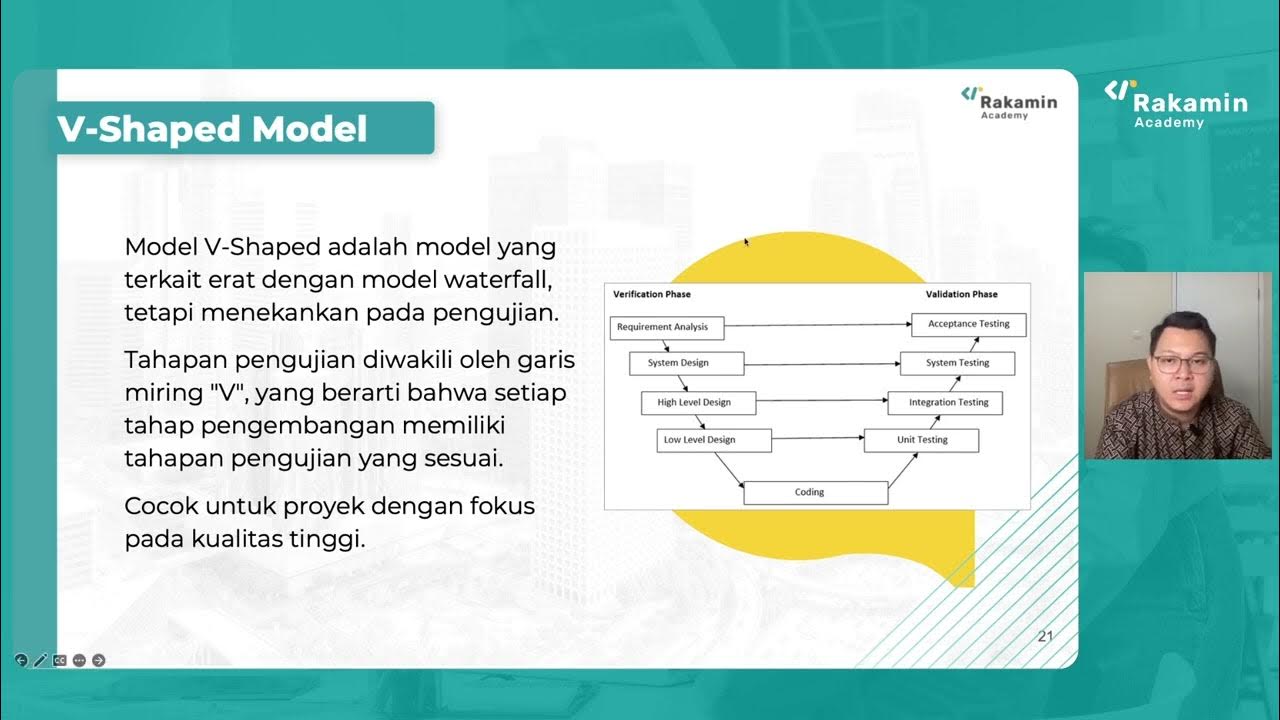Software Testing Tutorial #9 - V Model in Software Engineering
Summary
TLDRThis tutorial introduces the V-Model, an improvement over the Waterfall model in software development. It addresses the delay in testing in the Waterfall approach by involving the testing team at every stage of the development process. The video explains how the V-Model aligns testing phases with corresponding development phases, such as writing test cases during requirements gathering and system design. This early involvement of testers helps identify defects earlier, ensuring better quality and feedback throughout the lifecycle. The tutorial also highlights the advantages of the V-Model over the Waterfall model.
Takeaways
- 📋 V-Model is an improvement over the Waterfall Model, addressing its major drawback: delayed feedback in testing.
- ⏳ The main issue with the Waterfall Model was the late involvement of testing, leading to delayed defect detection.
- 💡 In the V-Model, testing is incorporated at every phase, with corresponding test phases for each development phase.
- 📝 During the requirements gathering phase, the testing team starts writing user acceptance test cases to catch defects early.
- 🔍 The system analysis and design phase involves understanding how the new system will interact with other systems, while testers write system test cases for end-to-end testing.
- ⚙️ In the global design phase, the testing team prepares integration test cases to ensure modules work together after coding.
- 🧩 During the detailed design phase, testers create unit test cases for individual modules. These are often written by developers but might involve white-box testers.
- 👨💻 The coding phase begins once the design is complete, and testing execution starts immediately for unit tests and integration tests as modules are developed.
- 🌐 Integration testing begins when multiple modules are ready and integrated, ensuring proper interaction between them.
- ✅ System testing and user acceptance testing follow, ensuring that the entire system works as expected and meets the customer's requirements.
Q & A
What is the V-Model in software development?
-The V-Model is an extension of the traditional waterfall model where each development phase has a corresponding testing phase. It is named after the V-shape formed by the process stages, representing an improvement in feedback and testing involvement over the waterfall model.
How does the V-Model address the disadvantages of the waterfall model?
-The V-Model addresses the major disadvantage of the waterfall model, which is the delayed feedback in testing. In the V-Model, testing is integrated into each development phase, ensuring that defects are identified and addressed early in the process.
What is the role of the testing team during the requirements phase in the V-Model?
-During the requirements phase, the testing team starts writing the user acceptance test cases based on the gathered requirements. This early involvement allows them to spot potential gaps and issues before the development begins.
What is the system analysis and design phase in the V-Model?
-In the system analysis and design phase, teams analyze how the new software will interact with other systems, including third-party and internal systems. Testers start writing system test cases during this phase to prepare for end-to-end system testing.
What is global design in the V-Model, and what happens during this phase?
-Global design refers to the high-level design of the core application being developed. During this phase, the tech architects determine what changes are needed in the core system. The testing team writes integration test cases to test how the new application will interact with other systems.
What are unit tests in the V-Model, and who typically writes them?
-Unit tests focus on testing individual modules of the software during the module-level design phase. These tests are usually written by the development team, but white-box testers may also write unit test cases if necessary.
What is the purpose of integration testing in the V-Model?
-Integration testing in the V-Model occurs after individual modules have been developed and integrated. Its purpose is to test how the modules work together and ensure that the integration between different parts of the software functions correctly.
What is system testing in the V-Model?
-System testing is conducted once the entire software is developed and integrated with other systems. It verifies that the complete system, including interactions with third-party or external systems, functions as expected.
What is user acceptance testing (UAT) in the V-Model?
-User acceptance testing (UAT) occurs after system testing and is performed by business users or customers. It focuses on ensuring that the software meets the customer's requirements and is fit for use. The UAT team typically uses test cases written during the requirements phase.
Why is the V-Model considered advantageous compared to the waterfall model?
-The V-Model is considered advantageous because it involves the testing team throughout the development process, allowing defects to be identified and addressed earlier. This reduces the risk of issues being discovered late in the development cycle, leading to a more efficient and higher-quality development process.
Outlines

هذا القسم متوفر فقط للمشتركين. يرجى الترقية للوصول إلى هذه الميزة.
قم بالترقية الآنMindmap

هذا القسم متوفر فقط للمشتركين. يرجى الترقية للوصول إلى هذه الميزة.
قم بالترقية الآنKeywords

هذا القسم متوفر فقط للمشتركين. يرجى الترقية للوصول إلى هذه الميزة.
قم بالترقية الآنHighlights

هذا القسم متوفر فقط للمشتركين. يرجى الترقية للوصول إلى هذه الميزة.
قم بالترقية الآنTranscripts

هذا القسم متوفر فقط للمشتركين. يرجى الترقية للوصول إلى هذه الميزة.
قم بالترقية الآنتصفح المزيد من مقاطع الفيديو ذات الصلة

V Shaped Model with examples | SDLC | Software Engineering

Software Testing Tutorial #10 - Iterative Model in Software Engineering

Lecture 07: Life Cycle Model (Contd.)

Software Testing Tutorial #6 - Software Development Life Cycle (SDLC)

Sub Topic 2

Macam-macam siklus hidup dalam pengembangan proyek | kelompok 8 | X.B
5.0 / 5 (0 votes)
